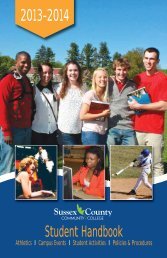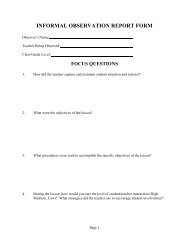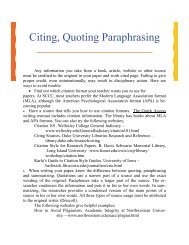1 Fill in the Blanks: FINAL EXAM CINEMATOGRAPHY SPRING ...
1 Fill in the Blanks: FINAL EXAM CINEMATOGRAPHY SPRING ...
1 Fill in the Blanks: FINAL EXAM CINEMATOGRAPHY SPRING ...
Create successful ePaper yourself
Turn your PDF publications into a flip-book with our unique Google optimized e-Paper software.
<strong>Fill</strong> <strong>in</strong> <strong>the</strong> <strong>Blanks</strong>: <strong>FINAL</strong> <strong>EXAM</strong> <strong>CINEMATOGRAPHY</strong> <strong>SPRING</strong> 2012<br />
1) A Long-shot at <strong>the</strong> beg<strong>in</strong>n<strong>in</strong>g of a sequence tell<strong>in</strong>g <strong>the</strong> audience where and<br />
when <strong>the</strong> action is tak<strong>in</strong>g place is called an ______________________ shot.<br />
2) A _________________ shot might be a close-up of a letter, follow<strong>in</strong>g a shot of a<br />
character open<strong>in</strong>g his mail and look<strong>in</strong>g down to beg<strong>in</strong> read<strong>in</strong>g.<br />
3) The editorial term for a sequence created by cutt<strong>in</strong>g a long-shot of a person<br />
fall<strong>in</strong>g, followed by a close-up of him hitt<strong>in</strong>g <strong>the</strong> floor is called _____________ on<br />
_________________<br />
4) Like <strong>the</strong> name says, A _____________ Shot depicts TWO characters.<br />
5) A _______________ Shot is a wide shot of <strong>the</strong> entire scene.<br />
6) Carefully study<strong>in</strong>g content and break<strong>in</strong>g it down <strong>in</strong>to pieces that are easily<br />
understood by <strong>the</strong> viewer and <strong>the</strong>n re-assembl<strong>in</strong>g <strong>the</strong>m to guide <strong>the</strong><br />
audience through <strong>the</strong> scene is known as _______________________ Edit<strong>in</strong>g.<br />
7) SCALE is important to consider <strong>in</strong> lay<strong>in</strong>g-out a scene. Typically, we meet<br />
groups of two or more characters <strong>in</strong> Long-Shot. As we get to know <strong>the</strong>m we<br />
might _________________________ <strong>the</strong> scale to become more <strong>in</strong>timate with <strong>the</strong>m.<br />
8) “Cutt<strong>in</strong>g on Action” is one type of ______________________ to l<strong>in</strong>k toge<strong>the</strong>r two<br />
shots so <strong>the</strong>y appear cont<strong>in</strong>uous, and as if <strong>the</strong>y are occurr<strong>in</strong>g <strong>in</strong> <strong>the</strong> same<br />
time and space.<br />
9) The ________________rule ma<strong>in</strong>ta<strong>in</strong>s that <strong>the</strong> “l<strong>in</strong>e” formed by two people<br />
<strong>in</strong>teract<strong>in</strong>g must be respected dur<strong>in</strong>g camera placement.<br />
10) Ano<strong>the</strong>r common edit<strong>in</strong>g practice that helps l<strong>in</strong>k two separate shots is called<br />
“Shot, followed by ________________ shot”.<br />
1
11) Shot = Scene is a primitive filmmak<strong>in</strong>g technique. It came about because<br />
early filmmakers were tra<strong>in</strong>ed <strong>in</strong> _________________________.<br />
12) Hear<strong>in</strong>g a sound without see<strong>in</strong>g its source, or show<strong>in</strong>g a character speak<strong>in</strong>g<br />
to an unseen listener rem<strong>in</strong>ds <strong>the</strong> viewer that <strong>the</strong>re is a larger world beyond<br />
<strong>the</strong> frame l<strong>in</strong>es. This is known as _________________ Space<br />
13) A _____________ Shot <strong>in</strong>cludes an entire figure from head to toe.<br />
14) A _______________ Shot might show only his face or even a s<strong>in</strong>gle eye.<br />
15) Two pieces of film that may have orig<strong>in</strong>ated <strong>in</strong> different spaces and at<br />
different times take on a s<strong>in</strong>gle mean<strong>in</strong>g by be<strong>in</strong>g placed next to each o<strong>the</strong>r<br />
<strong>in</strong> <strong>the</strong> timel<strong>in</strong>e. This is called______________________.<br />
16) “Lead<strong>in</strong>g with Audio” is a way to “BRIDGE” two shots so <strong>the</strong>y flow<br />
cont<strong>in</strong>uously.<br />
TRUE<br />
FALSE<br />
The THREE Questions.<br />
1) State Question #1. Elaborate.<br />
2) State Question #2. Elaborate.<br />
3) State Question #3. Elaborate.<br />
4) How often should a filmmaker ask himself <strong>the</strong>se questions<br />
2
Which image below uses a SHALLOW depth of field A or B<br />
A<br />
B<br />
3
Which Image below uses HIGH-KEY light<strong>in</strong>g scheme A (female) or B (male)<br />
a b<br />
4
This exam is complete. The pages follow<strong>in</strong>g are guides for you to keep and refer to<br />
as your work progresses. They deal with <strong>the</strong> “180 rule” and <strong>the</strong> “master and 2 over<br />
<strong>the</strong> shoulder set-ups”. REMEMBER<br />
THEM!<br />
5














